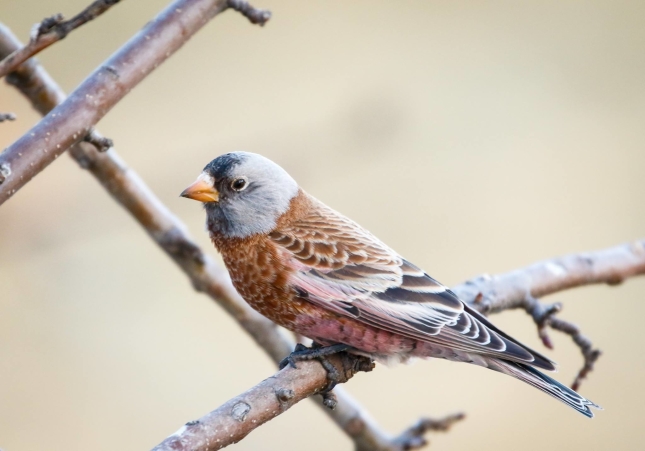FUN GRAY-CROWNED ROSY-FINCH FACTS

Gray-crowned Rosy-Finch photo by JT
APPEARANCE:
- When compared to the size of other finches, the Gray-crowned Rosy-Finch would be considered a medium size finch
- The coloration of the Gray-crowned Rosy-Finch is a dark brown, with gray cheek patches that wrap around the back of the head
- Their foreheads are black
- Belly, rump and wings are a pinkish color
- Juvenile Gray-crowned Rosy-Finches are duller in color than the adult female and lack the gray crown, black forehead and pinkish belly, rump and wings
- Length: 5.5-8.3 in.
- Wingspan: 13 in.
- Weight: 0.8-2.1 oz
SONG:
- The call of the Gray-crowned Rosy-Finch is a buzzy "Chew" sound
HABITAT:
- Gray-crowned Rosy-Finches live in extreme environments, in open ground at the tops of mountains from Alaska to California
- They also inhabit the Alaskan Aleutian and Pribilof islands
- During breeding season the Gray-crowned Rosy-Finch can be found in alpine areas, near now fields, or glaciers, talus, rock piles and cliffs
- In the winter they can be found in open country, including mountain meadows, shrub lands, roadsides, towns, farmland, rocky hillsides, and beside dry ditches
FOOD:
- Favorite foods for the Gray-crowned Rosy-Finch are seed, insects and some vegetation
- They will pick insects from low growing plants and from snowfields
- Gray-crowned Rosy-Finches will also capture flying insects and forage in conifers
NESTING:
- The nest off the Gray-crowned Rosy-Finch is shaped like a bulky cup and is made of moss, lichen, grass, and sedge
- Inside, the nest is lines with hair, fine grass, wool, and feathers
- Placement of the nest is usually in a crack or hole in a cliff; however, the Gray-crowned Rosy-Finch will sometimes make its nest on the ground
- Rarely will the Gray-crowned Rosy-Finch make its nest on a building
- Their nests are usually hidden in the cracks or crevasses of cliffs, or among boulders
- Clutch size: 2-6 eggs
- Egg description: White, without marks, or with some reddish or brownish speckles
- Condition at Hatching: Helpless. They are covered with long gray down that barely covered the skin
ATTRACTING GRAY-CROWNED ROSY-FINCHES TO YOUR YARD:
- Gray-crowned Rosy finches will eat from backyard feeders
- Feeder preferences are the large tube feeders, small tube feeders, large hopper feeders, and the small hopper feeders
- Food preferences, when eating from feeders, are black oil sunflower seeds, hulled sunflower seeds, and Nyjer
OTHER FUN GRAY-CROWNED ROSY-FINCH FACTS:
- There are six subspecies of the Gray-crowned Rosy-Finch
- Of the six subspecies, the Pribilof and Aleutian types are larger, weighing roughly twice the smaller subspecies
- Three of the subspecies, found in the interior mountains, have brown cheeks, while the others have gray cheeks
- Gray-crowned Rosy-finches are pretty fearless, perhaps because of their remote breeding grounds. Therefore, foraging birds can be approached within 3-6 feet
- Few Gray-crowned Rosy-Finch nests have been found, perhaps because of their remote locations
- Six years and seven months of age when captured for banding and released back into the wild, is the age of the oldest recorded Gray-crowned Rosy-Finch

